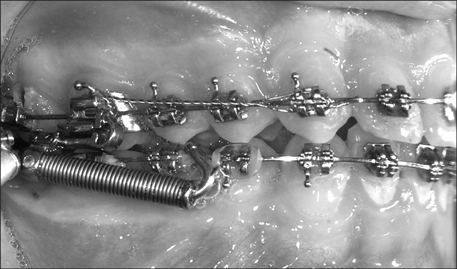Korean J Orthod.
2014 May;44(3):136-142. 10.4041/kjod.2014.44.3.136.
Active-treatment effects of the Forsus fatigue resistant device during comprehensive Class II correction in growing patients
- Affiliations
-
- 1Department of Human Morphology and Biomedical Sciences, School of Dentistry, University of Milan, Milan, Italy.
- 2Department of Orthodontics, Case Western Reserve University, Cleveland, OH, USA.
- 3Department of Surgery and Translational Medicine, University of Florence, Florence, Italy. lorenzo.franchi@unifi.it
- 4Department of Biomedical Sciences for Health, University of Milan, Milan, Italy.
- KMID: 1974999
- DOI: http://doi.org/10.4041/kjod.2014.44.3.136
Abstract
OBJECTIVE
To evaluate the active-treatment effects of the Forsus fatigue resistant device (Forsus) during comprehensive correction of Class II malocclusion in growing patients.
METHODS
Fifty-four patients (mean age, 12.5 +/- 1.2 years) with Class II division 1 malocclusion were consecutively treated with fixed app-liances in combination with Forsus. Lateral cephalograms were analyzed at the beginning of the fixed treatment (T1), Forsus insertion (T2), its removal (T3), and end of the comprehensive therapy (T4). Statistical comparisons were carried out by repeated-measures ANOVA with Tukey's post-hoc test (p < 0.05).
RESULTS
The overall therapeutic effects were mainly dentoalveolar and occurred mostly during the active treatment with Forsus (T2-T3, mean duration = 0.5 +/- 0.1 years). The overjet and overbite decreased significantly (-3.5 and -1.5 mm, respectively) and the molar relationship improved by 4.3 mm. These changes were associated with significant retroclination of the maxillary incisors (-3.1degrees), proclination and intrusion of the mandibular incisors (+5.0degrees and -1.5 mm, respectively), and mesialization of the mandibular molars (+2.0 mm).
CONCLUSIONS
Forsus had mainly dentoalveolar effects and contributed largely to the overall therapeutic outcome.
Figure
Cited by 1 articles
-
Predictors of favorable soft tissue profile outcomes following Class II Twin-block treatment
Ji-Eun Kim, Su-Jung Mah, Tae-Woo Kim, Su-Jung Kim, Ki-Ho Park, Yoon-Goo Kang
Korean J Orthod. 2018;48(1):11-22. doi: 10.4041/kjod.2018.48.1.11.
Reference
-
1. Bos A, Hoogstraten J, Prahl-Andersen B. On the use of personality characteristics in predicting compliance in orthodontic practice. Am J Orthod Dentofacial Orthop. 2003; 123:568–570.
Article2. Story RI. Psychological issues in orthodontic practice. Am J Orthod. 1966; 52:584–598.
Article3. El-Mangoury NH. Orthodontic cooperation. Am J Orthod. 1981; 80:604–622.
Article4. Sahm G, Bartsch A, Witt E. Micro-electronic monitoring of functional appliance wear. Eur J Orthod. 1990; 12:297–301.
Article5. Cureton SL, Regennitter FJ, Yancey JM. Clinical versus quantitative assessment of headgear compliance. Am J Orthod Dentofacial Orthop. 1993; 104:277–284.
Article6. Pancherz H. The mechanism of Class II correction in Herbst appliance treatment. A cephalometric investigation. Am J Orthod. 1982; 82:104–113.7. Schiavoni R. The Herbst appliance updated. Prog Orthod. 2011; 12:149–160.
Article8. Pangrazio-Kulbersh V, Berger JL, Chermak DS, Kaczynski R, Simon ES, Haerian A. Treatment effects of the mandibular anterior repositioning appliance on patients with Class II malocclusion. Am J Orthod Dentofacial Orthop. 2003; 123:286–295.
Article9. Ghislanzoni LT, Toll DE, Defraia E, Baccetti T, Franchi L. Treatment and posttreatment outcomes induced by the Mandibular Advancement Repositioning Appliance; a controlled clinical study. Angle Orthod. 2011; 81:684–691.
Article10. Jasper JJ, McNamara JA Jr. The correction of interarch malocclusions using a fixed force module. Am J Orthod Dentofacial Orthop. 1995; 108:641–650.
Article11. Küçükkeleş N, Ilhan I, Orgun IA. Treatment efficiency in skeletal Class II patients treated with the jasper jumper. Angle Orthod. 2007; 77:449–456.
Article12. Stromeyer EL, Caruso JM, DeVincenzo JP. A cephalometric study of the Class II correction effects of the Eureka Spring. Angle Orthod. 2002; 72:203–210.13. Bowman AC, Saltaji H, Flores-Mir C, Preston B, Tabbaa S. Patient experiences with the Forsus Fatigue Resistant Device. Angle Orthod. 2013; 83:437–446.
Article14. Jones G, Buschang PH, Kim KB, Oliver DR. Class II non-extraction patients treated with the Forsus Fatigue Resistant Device versus intermaxillary elastics. Angle Orthod. 2008; 78:332–338.
Article15. Franchi L, Alvetro L, Giuntini V, Masucci C, Defraia E, Baccetti T. Effectiveness of comprehensive fixed appliance treatment used with the Forsus Fatigue Resistant Device in Class II patients. Angle Orthod. 2011; 81:678–683.
Article16. Aras A, Ada E, Saracoğlu H, Gezer NS, Aras I. Comparison of treatments with the Forsus fa-tigue resistant device in relation to skeletal maturity: a cephalometric and magnetic resonance imaging study. Am J Orthod Dentofacial Orthop. 2011; 140:616–625.
Article17. Gunay EA, Arun T, Nalbantgil D. Evaluation of the immediate dentofacial changes in late adolescent patients treated with the Forsus(™) FRD. Eur J Dent. 2011; 5:423–432.18. McNamara JA Jr. Early intervention in the transverse dimension: is it worth the effort? Am J Orthod Dentofacial Orthop. 2002; 121:572–574.
Article19. Baccetti T, Franchi L, McNamara JA. The cervical vertebral maturation (CVM) method for the assessment of optimal treatment timing in den-tofacial orthopedics. Semin Orthod. 2005; 11:119–129.
Article20. Steiner CC. Cephalometrics for you and me. Am J Orthod. 1953; 39:729–755.
Article21. Jacobson A. The "Wits" appraisal of jaw disharmony. Am J Orthod. 1975; 67:125–138.
Article22. Ricketts RM. Perspectives in the clinical application of cephalometrics. The first fifty years. Angle Orthod. 1981; 51:115–150.23. McNamara JA Jr. A method of cephalometric valuation. Am J Orthod. 1984; 86:449–469.24. Shroff B, Lindauer SJ. Leveling and aligning: Challenges and solutions. Semin Orthod. 2001; 7:16–25.
Article25. Phan KL, Bendeus M, Hägg U, Hansen K, Rabie AB. Comparison of the headgear activator and Herbst appliance-effects and post-treatment changes. Eur J Orthod. 2006; 28:594–604.
Article26. Aslan BI, Kucukkaraca E, Turkoz C, Dincer M. Treatment effects of the Forsus Fatigue Resistant Device used with miniscrew anchorage. Angle Orthod. 2014; 84:76–87.
Article27. Pancherz H, Anehus-Pancherz M. The headgear effect of the Herbst appliance: a cephalometric long-term study. Am J Orthod Dentofacial Orthop. 1993; 103:510–520.
Article
- Full Text Links
- Actions
-
Cited
- CITED
-
- Close
- Share
- Similar articles
-
- Effects of activator treatment on different skeletal patterns in growing class II malocclusion patients
- Effects of elastic open activator in Class II malocclusion
- A study of the etiology of unilateral Class II, division 1 malocclusion
- Medical device clinical trial
- Transcription of class II MHC gene by interferon-gamma in FRTL-5 cells


